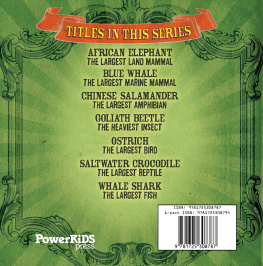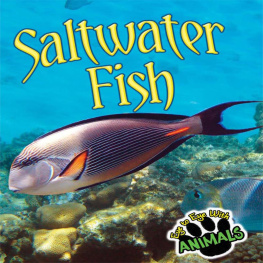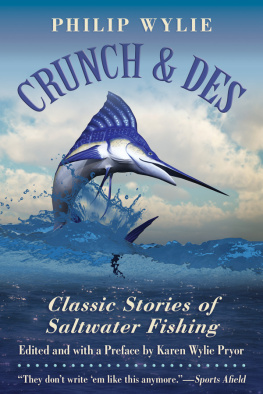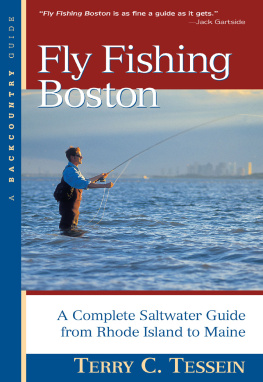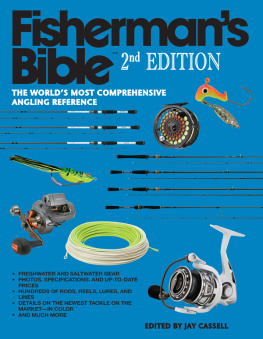Milt Rosko - Complete Book of Saltwater Fishing
Here you can read online Milt Rosko - Complete Book of Saltwater Fishing full text of the book (entire story) in english for free. Download pdf and epub, get meaning, cover and reviews about this ebook. year: 2013, publisher: Burford Books, genre: Home and family. Description of the work, (preface) as well as reviews are available. Best literature library LitArk.com created for fans of good reading and offers a wide selection of genres:
Romance novel
Science fiction
Adventure
Detective
Science
History
Home and family
Prose
Art
Politics
Computer
Non-fiction
Religion
Business
Children
Humor
Choose a favorite category and find really read worthwhile books. Enjoy immersion in the world of imagination, feel the emotions of the characters or learn something new for yourself, make an fascinating discovery.

- Book:Complete Book of Saltwater Fishing
- Author:
- Publisher:Burford Books
- Genre:
- Year:2013
- Rating:3 / 5
- Favourites:Add to favourites
- Your mark:
- 60
- 1
- 2
- 3
- 4
- 5
Complete Book of Saltwater Fishing: summary, description and annotation
We offer to read an annotation, description, summary or preface (depends on what the author of the book "Complete Book of Saltwater Fishing" wrote himself). If you haven't found the necessary information about the book — write in the comments, we will try to find it.
Complete Book of Saltwater Fishing — read online for free the complete book (whole text) full work
Below is the text of the book, divided by pages. System saving the place of the last page read, allows you to conveniently read the book "Complete Book of Saltwater Fishing" online for free, without having to search again every time where you left off. Put a bookmark, and you can go to the page where you finished reading at any time.
Font size:
Interval:
Bookmark:
I suspect that with the passage of time one develops a greater appreciation of the people and circumstances that have resulted in ones destiny. As I sit to acknowledge the people and circumstances that have aided me throughout a lifetime I reach back many years.
Little did I realize that June Whitmeyer, the attractive young girl who sat alongside me in junior high, would one day become my wife. She is mother to our two wonderful children. Bob married Kelly and had two of our granddaughters, Kristine and Kelsey. Linda married Joe and also had two of our granddaughters, with Jacqueline marrying Anthony and soon we had two great-granddaughters, Caitlyn and Chloe. Jennifer married Fran and we were blessed with Leo,our first great-grandson. The older girls all caught their first fish while fishing with Grandma and Grandpa and of course our three great-grandchildren someday will be anglers, too.
Moving back to school days for a moment there was a very young English teacher at West Side High School in Newark, New Jersey. Miss Rizzolo always had a smile and patience beyond words when it came to me. I authored many fishing stories as English compositions. She encouraged me with words I remember to this day. Keep trying, Milton. Eventually youll get it right!
An average student overall, I was a straight-A student in typing. Miss Carpenter strolled back and forth as we typed asdf jkl; for hour after hour. Little did I realize that the skills I learned on those vintage Underwoods would serve me so well in the years to come. They were there in every aspect of my life, in the Marine Corps, in my love of journalism, and in my 45-year professional career in management at Anheuser-Busch.
June never thought shed become a cover photographer. As my right arm as we traveled about, she recorded on film thousands of images. Many appeared as covers on national publications, in articles and books. June was the typist of many of my manuscripts of prior books. She is most thankful that now, by just pressing a key, the computers printer takes over and does the finished copy while shes cooking dinner!
As to the content of this treatise, I struggled as I tried to rightfully acknowledge those people who directly assisted in this work. The first person to come to mind was the late Frank Woolner, editor of Salt Water Sportsman, who in 1954 published my first article. I authored and typed it on a vintage Underwood in the USO located in the lobby of the Philadelphia YMCA. For it was there that I was billeted prior to release, after having served in the Marine Corps during the Korean War. Frank was my writing mentor. He was a gentleman, absolutely great fisherman, and superb editor who aided me tremendously.
Throughout this book are numerous line drawings that clearly depict a variety of tackle, knots, and techniques far more clearly than could photographs. They are the work of Alan Sherman, a talented young artist from Manasquan, New Jersey. He painstakingly created the drawings after viewing my samples of terminal rigs, tackle, boats, and penciled illustrations. I am indebted to Alan for his perseverance and am pleased that his quality art is herein being presented to a national audience.
A special thanks to the great anglers, both women and men, who shared photos of memorable catches to be included as part of this work. We have shared many days together and recorded images on film beyond count, most recently digitally, which is much easier and more effective than using roll film and waiting a week for developing!
Then, too, there were so many people, in so many places, who helped me develop the skills and techniques that I am in this book attempting to pass on to you, the reader. I feared that a list of names could never be complete, for so many I just knew in a casual way. To all I say a sincere thank you. Youve made my days along the seacoast a great joy. As you read this book Im certain youll observe those tips, techniques, and methods that you were responsible for, and to you I am eternally thankful.
To June, shes made my life a continuous pleasure. Weve enjoyed countless years as we traveled about together, with our family and, now in retirement, often just the two of us. This work would never have been possible without her encouragement, companionship, and, importantly, Junes fine ability to capture on film the great experiences weve shared and are attempting to share here with you.
Milt Rosko
GETTING STARTED
W ITHIN THE WORLD OF SALTWATER FISHING there is a variety of basic fishing equipment that suits itself to specific types of fishing. This usually centers on the rod and reel used in seeking a particular species and the technique being employed to catch it. Throughout this book the balanced rod-and-reel combinations that are most appropriate for a specific type of fishing are discussed in depth within the chapters.
There are many additional items of tackle and equipment that saltwater fishermen employ. It would be redundant to discuss each type of line in each chapter. That would also be the case with hooks, swivels, sinkers, snaps, and the various pieces of allied equipment such as nets and gaffs, rod belts and shoulder harnesses. For ease in understanding, these topics will be described as part of getting started, thus making it more comfortable as you move through every aspect of the broad world of saltwater fishing.
There are many types of line used in saltwater fishing. Each is designed for a specific purpose, and each has attributes that lend it to the needs of the angler. Unfortunately, there is no one line that is suited to every angling situation, and as such it becomes important to have an understanding of each type of line and its application.

Its important to take your time when selecting tackle. Quality equipment makes saltwater fishing enjoyable, in that it is dependable and can withstand the onslaughts of a very corrosive environment. Balanced tackle also makes casting and lure presentation easier, and affords an opportunity to enjoy every moment of the challenge of landing a strong fish.
Lines made of nylon monofilament are by far the most popular with Americas saltwater anglers. Mono is appropriate for use in many applications, including trolling, casting, bottom fishing, chumming, and jigging. Saltwater anglers generally employ tests ranging from 8-pound for spinning and casting reels, on up to 80-pound when employing big-game tackle.
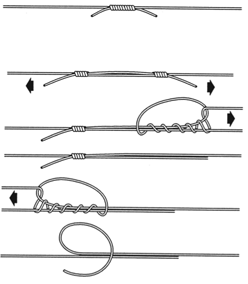
Uni-knot to join two lines
Overlap about 12 inches of the ends of two lines. Form a uniknot circle with the tag end of one line.
Wrap that line five times around the remaining line to form a uniknot around it. Snug the knot by gently pulling both ends of the line, but not so tightly that it grips the standing line.
Form another uniknot circle with the tag end of the remaining line and wrap that line five times to form a uniknot around the remaining standing line.
Firm up the second uniknot as you did the first. Then pull each line slowly, and they will slide together until they jam. Finish by tightening the wraps around the standing lines by firmly pulling the tag ends of each uniknot, and trim the tag ends with a nail clip.
Monofilament is available with a wide variety of features. Some is soft and supple, which makes it ideal for casting. Other monofilament is somewhat stiffer, yet offers more abrasion resistance and proves advantageous when bottom fishing, or wherever obstructions may be encountered. Most monofilament tends to stretch quite a bit, which can prove a disadvantage when bottom fishing in several hundred feet of water. The stretch can also be helpful, however, for as a result the line is very forgiving, such as when a fish makes a sudden run for freedom at boatside. Its important to read the label and select the line designed to closely fit the type of fishing you plan to do.
Font size:
Interval:
Bookmark:
Similar books «Complete Book of Saltwater Fishing»
Look at similar books to Complete Book of Saltwater Fishing. We have selected literature similar in name and meaning in the hope of providing readers with more options to find new, interesting, not yet read works.
Discussion, reviews of the book Complete Book of Saltwater Fishing and just readers' own opinions. Leave your comments, write what you think about the work, its meaning or the main characters. Specify what exactly you liked and what you didn't like, and why you think so.

